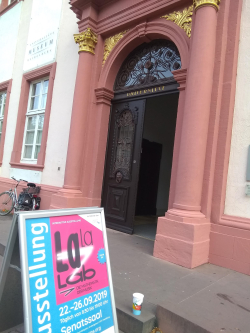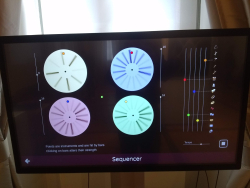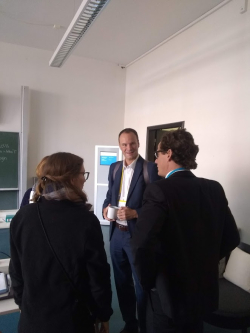First in a series of essays showing how my book, Living with Moore's Law: Past, Present and Future, interacts with the bleeding edge of software development at the Heidelberg Laureate Forum, where some of the biggest brains in software history try to inspire the next generation, and be inspired by it.
To learn more about the book, especially if you're an agent or publisher, write me and we'll talk
_____
 I got a demonstration of just how powerful Moore’s Law of Software has become at LaLa Lab, an exhibit being held in conjunction with the Heidelberg Laureate Forum.
I got a demonstration of just how powerful Moore’s Law of Software has become at LaLa Lab, an exhibit being held in conjunction with the Heidelberg Laureate Forum.
LaLaLab is subtitled The Mathematics of Music. It demonstrated the value of Digital Signal Processor, or encoders as Texas Instruments’ competitors call the. DSPs turn analog input into digital output or vice versa. Here they’re used not just to move the music, but to graphically show what’s going underneath, and let you interact with it.
A microphone and some instruments demonstrates how this works with a Fast Fourier Transform. Speech, the input of a variety of instruments, or just playing music comes up as beautiful diagrams ,showing just how “saturation arithmetic” fills a computer with input over time. The degree to which a note is played during each bit of a second is shown as white against the black of time itself. Each channel of input is separated, showing how a DSP can pick up a variety of types of sounds separately, giving a mixer control of it.
Nearby is a demonstration of how easy it is to control music. A tablet has sensors which turn your waving hand into output, “conducting” music from Chopin or Beethoven. The hand’s movements, and the system’s response, are displayed on a screen overhead.
There’s a lot to learn here about math, about music and about outputting results on a screen so people can understand it. I asked one of the people manning the booth how you can get the software. It’s all online, downloadable. All music teachers, or math teachers, need to do is build a curricula around it, using the extensive documentation in the booklet she handed me and the tools at Imaginary.org.
 This is a demonstration of how Moore’s Law of Software powers the world. Back in the 1990s she might have handed mew a CD, or a DVD. A decade ago she could have delivered a primitive version of the displays and I could have have spent an hour downloading the files needed to run one. Now, thanks to broadband and clouds, it’s all right there, ready to be used in your classroom. Just click and explore, design your curriculum, and bring in the kids.
This is a demonstration of how Moore’s Law of Software powers the world. Back in the 1990s she might have handed mew a CD, or a DVD. A decade ago she could have delivered a primitive version of the displays and I could have have spent an hour downloading the files needed to run one. Now, thanks to broadband and clouds, it’s all right there, ready to be used in your classroom. Just click and explore, design your curriculum, and bring in the kids.
Imaginary's worek is funded by the same Foundation that runs the Forum. It uses an open source business model to deliver what it has as exhibits in museums, schools and universities. All the software is free but if you need help with the hardware and curricula they can sell it. Such business models give their primary benefits to users, not creators. That’s why Imaginary couldn't exist without the Foundation. But it's also why some in open source are rebelling at places like the recent Open Core Summit, demanding more control over the money they produce, making open source proprietary.
It all combines Moore’s Law of Content and what I call Moore’s Law of Training. The Law of Content is that it’s hard to get paid. Once something is available free like this the only way to get paid is with the support of a university contract. The Law of Training shows you could spend a year designing a school’s lessons around it, or learning from it, without absorbing it all.The Law of Content is that it’s hard to get paid. Once something is available free like this the only way to get paid is with the support of a university contract. The Law of Training shows you could spend a year designing a school’s lessons around it, or learning from it, without absorbing it all.
Getting people paid, and getting people taught, should be where the profits from Moore’s Law of Software are going. But they’re not. They’re going into the market caps of software companies, or those selling access to the software. The only way the people doing this free work get paid is if someone hands them a check, or they limit access to it. That goes for those doing the curricula design work as well.
These are the puzzlements of Moore’s Law that I’ve come to Heidelberg to learn about. Whether anyone here has any answers, given that these people aren’t attached to markets, is what I’m here to learn









